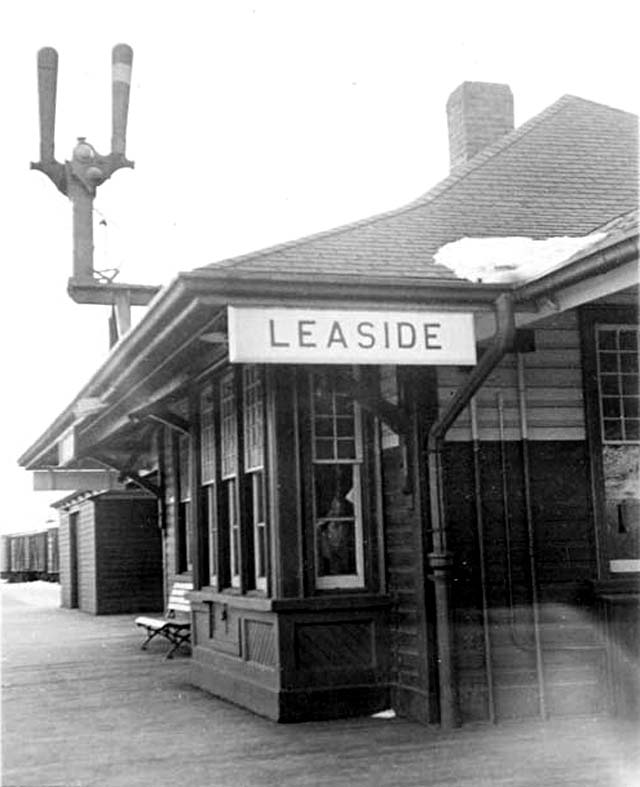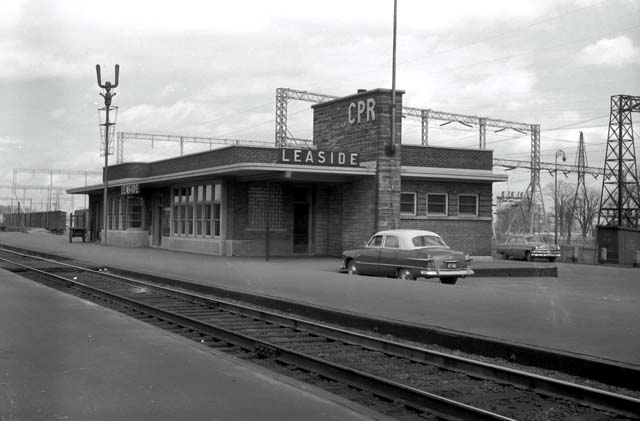|

|


Leaside station - Circa 1945 George Horner.
17 April 2013
Railways Helped to Build Community
Toronto Ontario - From pristine farmland, to prosperous town, to popular suburb, Leaside rode the rails all the way.
On 23 Apr 1913, the Town of Leaside, with its 43 residents, was incorporated by the Province of Ontario, at the request of the Canadian Northern Railway,
after the Town of North Toronto and old City of Toronto both refused offers to include Leaside in their boundaries.
William Mackenzie and Donald Mann, owners of the Canadian Northern Railway, had big plans for Leaside. They moved their company's rail yard there from the Don
Valley, purchasing more than 1,000 acres of land.
To finance the project, they hired planner Frederick Todd to design a town around the yard, with residential plots they could sell for profit.
"They started building all this stuff, a big locomotive repair shop and a huge yard, you know a big freight yard, a roundhouse, all the kinds of stuff
that the other railways had downtown," said railway historian Derek Bowles, from the Toronto Railway Historical Association.
"It was going to be the Canadian Northern Railway's principal locomotive shops for repairing locomotives in eastern Canada. The only problem with this was
that by 1917, the Canadian Northern Railway was essentially headed towards bankruptcy."
To keep it afloat, the Canadian government took over the railway, which was later merged with others to form Canadian National Railways, which already had a
yard in Stratford.
"It was never as important as was intended when the thing was built," said Bowles. "The big locomotive repair shop was abandoned by the Canadian
National probably in the 1930s, and it was used by a variety of businesses, and now of course it's the new Longo's grocery store."
While Canadian Northern Railway gave way to the Town of Leaside, it was the Canadian Pacific Railway that allowed Canadian Northern to put Leaside on the
map.
"Their line went up the Don Valley, but it didn't really go through Leaside, so they had to use CP tracks to get to Leaside," noted
Bowles.
The Canadian Pacific Railway, by way of the Ontario and Quebec Railway, was the first to lay tracks in the area, on land purchased from William Lea, son of
John Lea, the area's first settler.
"What the Canadian Pacific Railway was doing at the time was building the trans-continental railway across Canada, and where they had to build new
railways in Quebec and Ontario, they set up these separate companies, and the Ontario and Quebec Railway was one of those," Bowles explained.
Canadian Pacific Railway opened a passenger station there in 1894, which it called Leaside, after William Lea.
"The old station burned down in the 1940s after World War Two, and they built a brand new station," said Bowles, noting the new station cost $145,000
and opened 23 Nov 1946.
"Leaside by this time had replaced Don station as Canadian Pacific's principal eastern Toronto suburban station. All Canadian Pacific Toronto-Ottawa and
Toronto-Montreal passenger trains stopped at Leaside, until these trains were curtailed in 1966," he continued.
"Where Leaside became important was in 1892 when the CPR built a line going directly down the Don Valley, so if they were coming from Montreal or Ottawa,
they didn't have to go all the way around Toronto and come in through west Toronto, they could go directly downtown. It was called the Don Branch. And then,
where the track diverged to go down the Don Valley, that became known as Leaside Junction."
Passenger service ended at Leaside in 1992, when VIA Rail's Toronto-Havlock train no longer stopped there, he added.
Between 1975 and 1983, Leaside Station housed Canadian Pacific Hotel's Village Station restaurant, incorporating train cars into the decor. It was then used as
a freight accounting office, and is now home to the Canadian Pacific Police Service.
The Canadian Pacific Railway continues to operate freight trains through Leaside. The Don Branch is still there, but hasn't been used for about five or six
years, said Bowles, who added the line was recently sold to GO Transit.
The railways' impact is still evident in Leaside today, he noted.
"To the west of Laird Avenue there's this residential district, that was really started by the Canadian Northern Railway, and to the east of Laird Avenue,
is a very important industrial area that only in the last few years has been gentrified," he said.
"As industry is moving out of the city over the last 30 years or so, a lot of that industrial part of Leaside is now turning into big box stores, and
shopping malls, and residential developments, and so on, and I imagine that process will continue as industry moves out. The railways made all that
possible."
Tara Hatherly.

Leaside station - 8 Apr 1955 James Salmon.



Vancouver Island
British Columbia
Canada
|